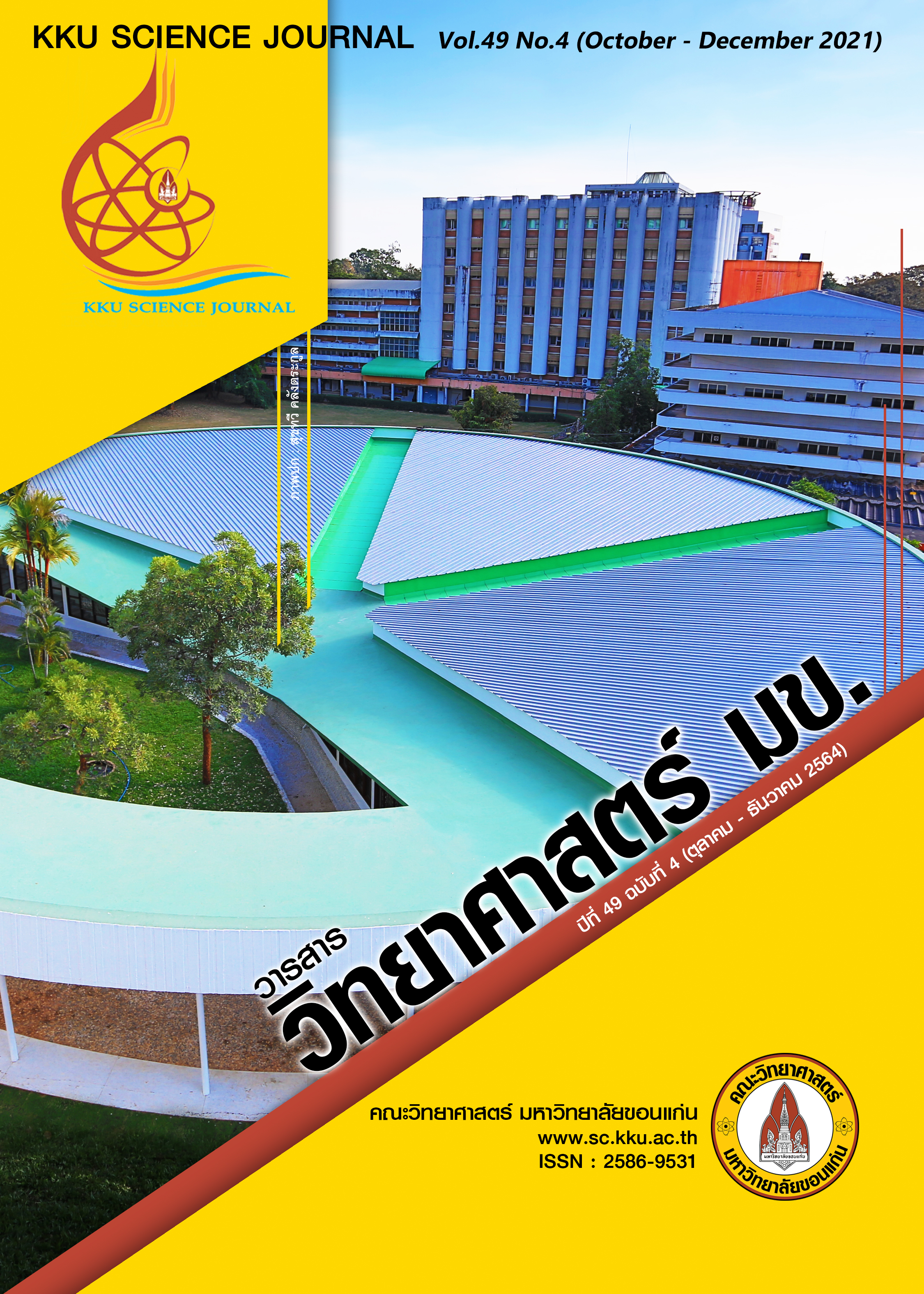Antioxidant activity, Antibacterial and Anti-biofilm formation of Curcuma zedoaria extract against Streptococcus mutans
Main Article Content
Abstract
Streptococcus mutans is a pathogenic oral bacterium that is the main cause of tooth decay. The objective of this research was evaluated the effect of Curcuma zedoaria extract on anti-oxidation, bacteria inhibition and resist the formation of biofilms. The quantitative study of total phenolic compounds and total flavonoid showed that Curcuma zedoaria contained total phenolic compounds and flavonoids. The antioxidant activity of DPPH, ABTS and FRAP assay was then studied. The result of antioxidant activity shown with IC50 values of 58.86 ± 1.98, 22.69 ± 3.91 µg/ml and 230.76 ± 0.25 mg FeSO4 equivalent/g extracts. Antibacterial activity by Disc diffusion method showed inhibition zone were 10.46 ± 0.55 mm at concentration 500 mg/mL. It was tested for antibacterial, bactericidal activity and resist biofilm formation. The results showed that the activity of Curcuma zedoaria extract had MIC and MBC values of 100 and 120 mg/ml and the extracts can inhibit biofilm formation. This was consistent with testing the effect of Curcuma zedoaria extract on bacterial biofilm formation under a phase contrast microscope. When the extract concentration increased, the amount of biofilm formation decreased. This research shows that Curcuma zedoaria extract is effective for further development as an oral antimicrobial product.
Article Details

This work is licensed under a Creative Commons Attribution-NonCommercial-NoDerivatives 4.0 International License.
References
Andrews, J. M. (2001). Determination of minimum inhibitory concentrations. Journal of antimicrobial Chemotherapy 48(1): 5-16.
Azahar, N. F., Abd Gani, S. S. and Mokhtar, N. F. M. (2017). Optimization of phenolics and flavonoids extraction conditions of Curcuma Zedoaria leaves using response surface methodology. Chemistry Central Journal 11(1): 1-10.
Bidault, P., Chandad, F. and Grenier, D. (2007). Risk of bacterial resistance associated with systemic antibiotic therapy in periodontology. Journal of the Canadian Dental Association 73(8): 721-725.
Bugno, A., Nicoletti, M. A., Almodóvar, A. A., Pereira, T. C. and Auricchio, M.T. (2007). Antimicrobial efficacy of Curcuma zedoaria extract as assessed by linear regression compared with commercial mouthrinses.
Brazilian Journal of Microbiology 38: 440-445. Burt, S. (2004). Essential oils: their antibacterial properties and potential applications in foods—a review. International journal of food microbiology 94(3): 223-253.
Himaja, M., Anand, R., Ramana, M. V., Anand, M. and Karigar, A. (2010). Phytochemical screening and antioxidant activity of rhizome part of Curcuma zedoaria. International Journal of Research in Ayurveda and Pharmacy 1(2): 414-417.
Jose, S. and Thomas, T. D. (2014). Comparative phytochemical and anti-bacterial studies of two indigenous medicinal plants Curcuma caesia Roxb. and Curcuma aeruginosa Roxb. International Journal of Green Pharmacy 8(1): 65-71.
Li, B., Li, X., Lin, H. and Zhou, Y. (2018). Curcumin as a promising antibacterial agent: effects on metabolism and biofilm formation in S. mutans. BioMed research international 3: 1-11.
Loesche, W. J. (1986). Role of Streptococcus mutans in human dental decay. Microbiological reviews 50(4): 353-380.
Mau, J. L., Lai, E. Y., Wang, N. P., Chen, C. C., Chang, C. H. and Chyau, C. C. (2003). Composition and antioxidant activity of the essential oil from Curcuma zedoaria. Food Chemistry 82(4): 583-591.
Nobosse, P., Fombang, E. N. and Mbofung, C. M. F. (2017). The effect of steam blanching and drying method on nutrients, phytochemicals and antioxidant activity of Moringa (Moringa oleifera L.) leaves. American Journal of Food Science and Technology 5(2): 53-60.
Palombo, E. A. (2011). Traditional medicinal plant extracts and natural products with activity against oral bacteria: potential application in the prevention and treatment of oral diseases. Evidence-based complementary and Alternative Medicine 1-11.
Rahman, A., Afroz, M., Islam, R., Islam, K. D., Hossain, M. A. and Na, M. (2014). In vitro antioxidant potential of the essential oil and leaf extracts of Curcuma zedoaria Rosc. Journal of Applied Pharmaceutical Science 4(2): 107-111.
Rahmatullah, M., Azam, M. N. K., Pramanik, S., Sania, S. R. and Jahan, R. (2012). Antihyperglycemic activity evaluation of rhizomes of Curcuma zedoaria Christm. roscoe and fruits of Sonneratia caseolaris. L. Engl. International Journal of PharmTech Research 4(1): 125-129.
Sabayjai, D., Bun-ek, A., Sutin, S., Sinlamuth, O., Nintasen, R. and Powtongsook, W. (2020) Antibacterial, Anti-biofilm and Antioxidant Activities of Chinese Herb Extracts Against Oral Cavity Bacteria. The Sci of Phetchaburi Rajabhat University 17(1): 33-44.
Sandrasari, D. A., Sabariman, M. and Azni, I. N. (2019). Determination of potential level of Indonesian
rhizomes as an antioxidant based on phenolic compound and antioxidant activity. In: IOP Conference Series: Earth and Environmental Science 383(1): 12-17.
Tangyuenyongwatana, P. and Gritsanapan, W. (2014). Prasaplai: An essential Thai traditional formulation for primary dysmenorrhea treatment. CELLMED 4(2): 10.1-10.8.
Turapra, B., Boonyarat, C., Chulikhit, Y. and Daodee, S. (2016). Determination of Active Constituents and Antioxidative Activity In: Citrus maxima (Burm.) Merr. Isan Journal of Pharmaceutical Sciences 11(5): 80-91.


